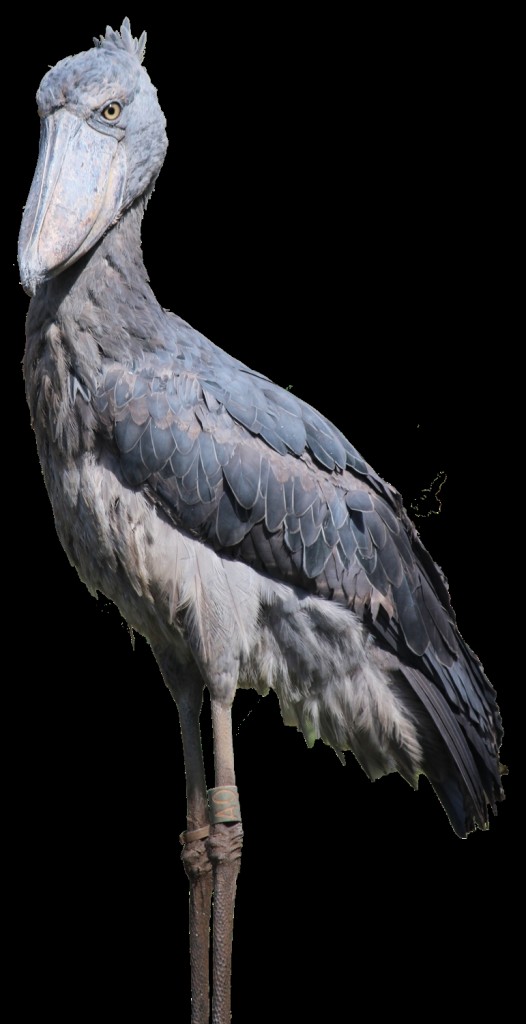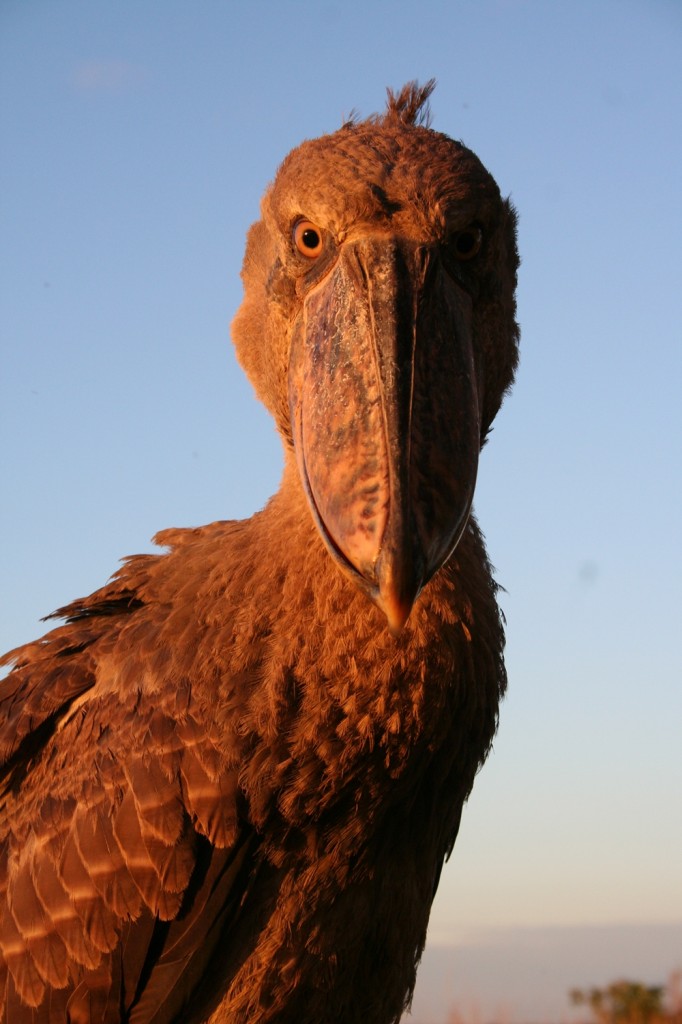 The pre-historic looking shoebill is on many people’s must-see list, and not only birders make the trip to the Bangweulu Wetlands to have a look at this strange creature. It is a long journey into the swamps, and even after hours of paddling, there is no guarantee that you will encounter this elusive bird. However, it is definitely an exciting moment when the guide says “Shoebill!” and you see a large grey bird standing in the distance. There is no bird like the shoebill; a tall and elegant bird with an oversized head and an enormous bill. Most people describe the bill as a wooden clog; it is massive, and gives the bird a permanent grin, which can be seen as friendly and mean at the same time.
The pre-historic looking shoebill is on many people’s must-see list, and not only birders make the trip to the Bangweulu Wetlands to have a look at this strange creature. It is a long journey into the swamps, and even after hours of paddling, there is no guarantee that you will encounter this elusive bird. However, it is definitely an exciting moment when the guide says “Shoebill!” and you see a large grey bird standing in the distance. There is no bird like the shoebill; a tall and elegant bird with an oversized head and an enormous bill. Most people describe the bill as a wooden clog; it is massive, and gives the bird a permanent grin, which can be seen as friendly and mean at the same time.
Shoebills are endemic to Africa, being resident in South Sudan, western Ethiopia, Uganda, Rwanda, eastern Democratic Republic of Congo, western Tanzania and northern Zambia. In the Bangweulu Wetlands we have the most southern population of breeding shoebills. The shoebill is a long-lived species and they probably reach an age of 20 to 25 years in the wild. They occur in large freshwater swamps with reeds, papyrus and tall grasses and mainly feed on fish, although the occasional snake and frog can also be on the menu. But the swamps are shared with another species interested in catching fish – fishermen. Where fishermen use deep channels, pools and the edges of floating vegetation, shoebills typically forage on top of the floating vegetation, a thick mat of grasses. Their preferred prey species in the Bangweulu is the catfish, also one of the fishermen’s favourites. Catfish hunt at night and hide underneath the floating vegetation during the day. During the night, catfish have to avoid the temptation of baited hooks set by fishermen, while during the day they have to stay away from the large beaks of shoebills. As oxygen is poor underneath the vegetation, catfish occasionally come up to the surface through holes in the vegetation to gulp in some air. A shoebill can stand for hours at the same breathing hole, waiting for catfish, and it can strike with surprising vigour and speed, collapsing onto the vegetation. Quite a spectacular sight, although fairly rare as well, as shoebills might catch only one fish per day.
During the breeding season, shoebills lay two eggs, eventually resulting in two little fluffy chicks without the distinctive bill, but with a rather normal looking one instead. You could even say they look cute. However, the stronger of the two, likely the first hatchling, will kill or chase away its sibling and only one chick might fledge. Both parents catch fish for the young and feed it on the nest. It takes about 90 to 100 days for a chick to leave the nest and it will then join the parents for a few months, learning to catch fish. During breeding, the shoebill is at its most vulnerable. The main disturbance is caused by humans; either fires destroying nests or people actually taking chicks from the nest in order to show to tourists or to sell to traders. Because of its particular looks, shoebills are much sought after by private collectors and unfortunately, the Bangweulu Wetlands is one of the most accessible places where shoebills occur.
Currently we think that the population in the Bangweulu consists of about 200 to 300 individuals, but human encroachment and the illegal trade are significant threats that might decrease the only shoebill population of Zambia. Bangweulu Wetlands is managed by a partnership comprising African Parks, ZAWA and the local communities. The Bangweulu Wetlands Project is playing a decisive role in protecting shoebills through the engagement of local fishermen to protect the nests and ensure that more chicks fledge annually. A research project is also underway that aims to learn more about these unique birds and guide management and protection into the future so that future generations of birders can also appreciate the sight of the remarkable shoebill in its’ natural environment
by Ralf Mullers


Leave a Reply
You must be logged in to post a comment.